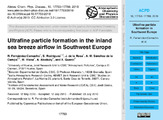Por favor, use este identificador para citar o enlazar este ítem:
http://hdl.handle.net/20.500.11765/6518
Ultrafine particle formation in the inland sea breeze airflow in Southwest Europe [Discussion paper]
| Título : | Ultrafine particle formation in the inland sea breeze airflow in Southwest Europe [Discussion paper] |
| Autor : | Fernández Camacho, Rocío; Rodríguez González, Sergio


|
| Palabras clave : | Ultrafine particles; Human health; Urban particles; Partículas; Calidad del aire |
| Fecha de publicación : | 2010 |
| Editor: | European Geosciences Union |
| Citación : | Atmospheric Chemistry and Physics Discussions [Preprint]. 2010, 10, p. 17753–17788 |
| Versión del editor: | http://dx.doi.org/10.5194/acpd-10-17753-2010 |
| Resumen : | Studies on ultrafine particles (diameter < 100nm) and air quality have mostly focused on vehicle exhaust emissions and on new particle formation in "clean" ambient air. Here we present a study focused on the processes contributing to ultrafine particle concentrations in a city (Huelva, SW Spain) placed close to a coastal area where significant anthropogenic emissions of aerosol precursors occur. The overall data analysis shows that two processes predominantly contribute to the number of particles coarser than 2.5 nm: vehicle exhaust emissions and new particle formation due to photo-chemical activity. As typically occurs in urban areas, vehicle exhaust emissions result in high concentrations of black carbon (BC) and particles coarser than 2.5 nm (N) during the morning rush hours. The highest N concentrations were recorded during the 11:00–17:00 h period, under the sea breeze regime, when low BC concentrations were registered and photochemical activity resulted in high O3 levels and in new particle formation in the aerosol precursors' rich inland airflow. In this period, it is estimated that about 80% of the number of particles are linked to sulfur dioxide emissions. The contributions to N of "carbonaceous material and those compounds nucleating/condensing immediately after emission" and of the "new particle formation processes in air masses rich gaseous precursors (e.g. SO2)" were estimated by means of a relatively novel method based on simultaneous measurements of BC and N. A comparison with two recent studies suggests that the daily cycles of "new particle formation" during the inland sea breeze is blowing period seem to be a feature of ultrafine particles in coastal areas of South-west Europe. |
| Patrocinador: | This study has been carried out within the framework of several research projects: AER-REG (P07-RNM-03125; Regional Ministry of Innovation, Science and Enterprise of the Andalusian Autonomous Government), GRACCIE (CSD2007-00067; Ministry of Science and Innovation of Spain), SIMAND (P07-RNM-02729; Regional Ministry of Innovation, Science and Enterprise of the Andalusian Autonomous Government) and EPAU (B026/2007/3-10.1; Ministry of Environment of Spain). |
| URI : | http://hdl.handle.net/20.500.11765/6518 |
| ISSN : | 1680-7367 1680-7375 |
| Colecciones: | Artículos científicos 2010-2014 |
Ficheros en este ítem:
| Fichero | Descripción | Tamaño | Formato | ||
|---|---|---|---|---|---|
| acpd-10-17753-2010.pdf | 1,86 MB | Adobe PDF |  Visualizar/Abrir |
Los ítems de Arcimis están protegidos por una Licencia Creative Commons, salvo que se indique lo contrario.





